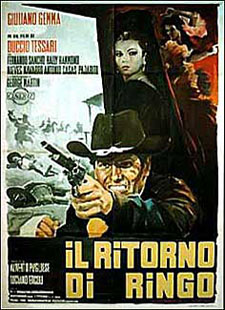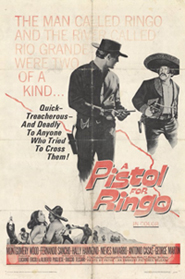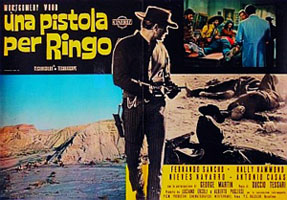There’s just something about the juxtapositions in A Pistol for Ringo that makes this film a unique and outrageous venture; something new and fresh amidst the tired old westerns of the era. It looks like a fairly typical (albeit low-budget) American western, but underneath there is much more going on. The wardrobe seems new and brightly  colored, even ironed and creased. The sets are freshly-painted and one step up from being cardboard cut-outs. The characters are wooden and widely-drawn and even Morricone’s score is upbeat and melodramatic. Yet…yet…there is an undercurrent of ferocity and pure mean-spiritedness that separates Pistol from its kin. There really aren’t any good guys (or girls for that matter) – they’re all morally reprehensible, every last one. Even the Sheriff, usually the upholder of all that is good, has his meter set to slaughter the entire time. As such, Pistol really can be seen as an important work that helped to usher in the new era of European style westerns – a clashing of old values and new – and I can’t help but wonder why it doesn’t get more acclaim for that fact alone.
colored, even ironed and creased. The sets are freshly-painted and one step up from being cardboard cut-outs. The characters are wooden and widely-drawn and even Morricone’s score is upbeat and melodramatic. Yet…yet…there is an undercurrent of ferocity and pure mean-spiritedness that separates Pistol from its kin. There really aren’t any good guys (or girls for that matter) – they’re all morally reprehensible, every last one. Even the Sheriff, usually the upholder of all that is good, has his meter set to slaughter the entire time. As such, Pistol really can be seen as an important work that helped to usher in the new era of European style westerns – a clashing of old values and new – and I can’t help but wonder why it doesn’t get more acclaim for that fact alone.
The mid-60’s were ostensibly the birth and infancy of the Spaghetti Western. Riding on the coattails of the double Leone whammy of A Fistful of Dollars and For a Few Dollars More (1964 & ‘65 respectively), the Italians took to the genre with outrageous panache, mimicking the likes of John Ford and the American westerns, yet swinging it all in a much more dark and dirty direction. A Pistol for Ringo arrived at the very beginning of the phenomenon, was directed by Duccio Tessari – whose previous experience was writing and assistant directing for the likes of Sergio Leone and Sergio Corbucci (and even a few stints with the maestro, Mario Bava), and kick-starting the career of pretty boy stuntman Giuliano Gemma. With a pedigree like that behind him, Tessari brought a skilled and boundary-pushing vision to his take on the old west.
Its Christmas time, and Ringo (AKA Angel Face) is imprisoned by the Sheriff after killing some gang members who were after the young gun-slinger for the murder of one of their companeros. Ringo claims self-defense, but the Sheriff knows otherwise. While Angel Face is in jail, a group of Mexican bandits led by the sadistic Sancho dupe the Sheriff and the townsfolk, rob the bank in broad daylight and make good their escape. The bandits don’t get too far, though, and hole up at a nearby ranch while the sheriff’s deputies surround them. Things get sticky when the bandits take the ranch workers and owners hostage and begin killing them one-by-one, sending the bodies out to the deputies on horseback. Even worse – the Sheriff’s future wife is the daughter of the ranch owner and one of the hostages.
The Sheriff and Colonel devise a scheme to send someone into the ranch undercover to win over the gang while the rest wait for military reinforcements. After much deliberation, the only choice turns out to be the sharp-shooting and silver-tongued Ringo. And so, with promises of a big cut of the  stolen loot, they release him from jail to infiltrate the gang and get the Sheriff’s girlfriend out safe and sound.
stolen loot, they release him from jail to infiltrate the gang and get the Sheriff’s girlfriend out safe and sound.
Pistol’s similarities to both Leone films is apparent, but certainly not overtly so. It was probably difficult to assemble a western at the time (and really, even to this day) that didn’t owe something to Leone. For instance, Ringo infiltrates the gang much like Mancho in For A Few Dollars More, and plays both sides much like Joe in Fistful of Dollars (Yojimbo style). Although, in truth, Gemma himself couldn’t be more different than the dusty Clint Eastwood, and was an interestingly clean-cut choice for a decidedly violent lead (there’s a reason his nickname is Angel Face, after all). Even the ranch itself resembles the location of the final climactic scenes in For a Few Dollars More, with pocket watches and all. One could imagine that Tessari would have certainly been privy to conversations and production meetings with Leone and Corbucci as they hashed out their westerns, and Tessari seems to have taken a few of these ideas to heart.
The violence, while not as gratuitous as some later Spaghettis, is nonetheless brutal and swift when it does happen. And given the tone of the film, when it does occur it seems that much more intense. Take for instance the sequence where an injured Sancho pops one of his buddies between the eyes for simply mentioning that the gang always leave the injured behind because they slow the gang down…so why treat Sancho differently? Because you don’t mess with Sancho, that’s why! And the murdering of the hostages is handled with an almost Corbucci-like nihilism. In one scene Sancho is shaving in a mirror and puts the six-shooter over his shoulder…aiming at the crowd of peasants via the mirror, not even glancing behind him to see where or who he is shooting. And on the opposite side of the spectrum, when we are introduced to Ringo, he is playing hopscotch with some children in a square one moment, the next he guns down four bandits in front of virtually the entire town without so much as a blink.

Tessari’s direction is really remarkable, and the framing itself is superb. He populates the screen so effectively that rarely is there any dead space, despite the often roaming camera-work. And the actors are blocked and choreographed wonderfully, with long shots making up the bulk of the drama and very few cuts to speak of. His use of foreground is essential here – props or actors stand close to the camera, and rarely just for stylistic sake. Take one scene involving Ringo in a long fist-fight with one of the bandits. Tessari has a row of saddles taking up 2/3 of the frame, while the fight happens in the far right side in another room entirely. Soon enough though, the two combatants tumble into the saddles and send them all flying and crashing to the floor. There’s really impressive attention to detail like that in many shots such as this, and I wonder what exactly happened that Tessari only made a few other quasi-notable films in his time (although he did direct the sequel to this film, The Return of Ringo, which many consider to be one of the very finest Spaghetti Westerns).
I guess I could touch more on the wooden acting and some of the more loose plot lines, mostly involving competition for the women in the film and some of the drama in the ranch, but alas, it’s not that important. Just know that while popping this into your DVD player and watching the first scenes that all is not what it seems. It’s got some excellent direction and some really fun and satisfying gunfights and action sequences, and as a fledgling Spaghetti Western just outside Leone’s rise to fame, is a very important and significant film in its own right.
Please feel free to discuss "A Pistol for Ringo" here, in our forums!

